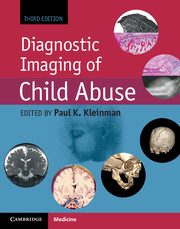Book contents
- Frontmatter
- Dedication
- Contents
- List of Contributors
- Editor’s note on the Foreword to the third edition
- Foreword to the third edition
- Foreword to the second edition
- Foreword to the first edition
- Preface
- Acknowledgments
- List of acronyms
- Introduction
- Section I Skeletal trauma
- Section II Abusive head and spinal trauma
- Section III Visceral trauma and miscellaneous abuse and neglect
- Section IV Diagnostic imaging of abuse in societal context
- Chapter 24 Psychosocial considerations
- Chapter 25 Child abuse and the law I: general issues for the radiologist
- Chapter 26 Child abuse and the law II: the radiologist in court and fundamental legal issues
- Chapter 27 The radiologist's response to child abuse
- Section V Technical considerations and dosimetry
- Index
- References
Chapter 24 - Psychosocial considerations
from Section IV - Diagnostic imaging of abuse in societal context
Published online by Cambridge University Press: 05 September 2015
- Frontmatter
- Dedication
- Contents
- List of Contributors
- Editor’s note on the Foreword to the third edition
- Foreword to the third edition
- Foreword to the second edition
- Foreword to the first edition
- Preface
- Acknowledgments
- List of acronyms
- Introduction
- Section I Skeletal trauma
- Section II Abusive head and spinal trauma
- Section III Visceral trauma and miscellaneous abuse and neglect
- Section IV Diagnostic imaging of abuse in societal context
- Chapter 24 Psychosocial considerations
- Chapter 25 Child abuse and the law I: general issues for the radiologist
- Chapter 26 Child abuse and the law II: the radiologist in court and fundamental legal issues
- Chapter 27 The radiologist's response to child abuse
- Section V Technical considerations and dosimetry
- Index
- References
Summary
Introduction
The technical and analytic challenges of a radiologic evaluation of suspected child abuse may be compounded by a variety of psychosocial factors. Radiology staff who interact with children and their families during the imaging assessment of suspected abuse may react with distrust, anger, sadness, disgust, or disbelief. Families of a possible victim of child maltreatment may be angry or defensive, and children who have a history of trauma may be more anxious or reactive than other patients, complicating the assessment by the radiology staff. Additionally, many adults working in the healthcare field have a history of personal experience with abuse or neglect in their own family or with a neighbor or friend (1), exacerbating the risk of a negative experience and compromised imaging assessment. This chapter is intended to provide a greater understanding of the psychosocial issues at work in cases of suspected abuse and how members of the diagnostic imaging team should approach the patient, as well as the families/guardians in cases of possible child abuse. As they seek to acquire and interpret imaging studies at a high level of proficiency, imaging professionals must carry out their responsibilities in a manner that will minimize the risk of secondary trauma arising from difficult patient or family interactions.
Child Abuse Pediatrics and the Child Protection Team
The field of Child Abuse Pediatrics became a board-certified pediatric specialty in 2009, requiring three years of fellowship training. Child Abuse Pediatricians (CAPs) are trained in an understanding of injuries which may occur in various organs, including the brain, digestive, renal, ocular, and skeletal systems. These specialists are also educated in the many radiologic approaches used to search for and characterize potentially abusive injuries, and radiologist collaboration with these experts is often critical in identifying subtle findings that may significantly impact cases as they progress through the legal system.
- Type
- Chapter
- Information
- Diagnostic Imaging of Child Abuse , pp. 633 - 637Publisher: Cambridge University PressPrint publication year: 2015



